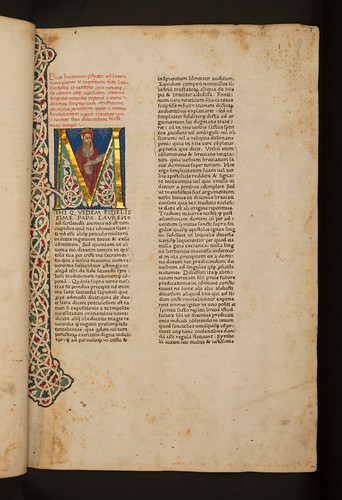Hieronymus, S.: Epistolae.
Edited by Theodorus Lelius. Preliminaries: [Pseudo-] Aristeas: Ad Philocratem De lxx interpretibus; translated by Matthias Palmerius.
[Rome: Sixtus Riessinger, ca. 1470].
Fol. Part I: [12 26 3-1910 2012 21-3610 378 3812 396]. [376] leaves (1/1, 37/6-8, 38/1, 39/4-6 i.e. ff. 1, 356-8, 359, 374-6 blank). Part II: [112 2-2410 258 26-4410 4512]. [452] leaves (1/1, 1/9-12, 45/12 i.e. ff. 1, 9-12, 452 blank).
ISTC ih00160800; GW 12420 (Hieronymus); GW 2330 (Aristeas); Goff H163; BMC IV 27 (IB. 17432); Bod-inc H-081; CIBN H-100; BSB-Ink H-243.
| GIP number: | H16 |
| Shelf-mark: | Sp Coll Hunterian Be.1.2, 3 (see main library entry for this item) |
| Note: | On the ascription to Riessinger at Rome, see BMC IV ix-x. On J.L. Sharpe's view that this should be dated [ca. 1466-67] see D.E. Rhodes in The Library, 6th series, 5 (1983), pp. 68-71, where a date of [not after 1467] is suggested. Dated [not after 1470] in Goff. Paul Needham in La Bibliofilia 116 (2014), pp. 17-44, shows that Riessinger used the edition of Sweynheym and Pannartz of 1468 as exemplar and therefore dates this work to [ca. 1470]. |
| Note: | GW catalogues the Aristeas as an independent edition, assigning it to Riessinger at Naples [ca. 1473-74]. |
| Note: | Bound in two volumes, with the Aristeas forming quires 38-39 at the end of vol. 1. Stubs showing for the missing blank leaves 37/6-8 (ff. 356-358) and 38/1 (f. 359) of part I. In this copy, quires 1 and 2 of part I have been amalgamated as a single quire by the binder with bifolium 1/1.2 forming the outer sheet of the quire. |
| Variants: | Part I: 24/4r (f. 224r), col. 1, line 1: “... naui||gare ...” not “... na||uigare ...”; 24/4v (f. 224v), col. 2, line 47 “... de epi||ſcopis ...” not “... de epiſ||copis ...” - cf. GW 12420 Anm. 3. |
| Provenance: | Edward Harley (1689-1741), Lord Harley; from 1724 2nd Earl of Oxford: see Binding. Thomas Osborne (d. 1767), bookseller: purchased all the Harleian printed books; top corner of first front flyleaf of vol. I cut off - as in many other Harleian volumes - probably by Osborne to remove his earlier price (cf. J.B. Oldham, Shrewsbury School bindings, p.114); revised price in pencil “2V 2=12=6” adjacent to excision; no. 719 in Osborne’s Catalogus bibliothecae Harleianae, vol. 1 (London: 1743) and no. 1520 in his Catalogus bibliothecae Harleianae, vol. 3 (London: 1744). William Hunter (1718-1783), physician and anatomist: source unknown. University of Glasgow: Hunterian bequest 1807; Hunterian Museum bookplate and book labels on front pastedowns, with former shelfmarks “Ac.1.1” and “Ac.1.2”. |
| Binding: | England, 18th-century gold-tooled red sheep, bound for Lord Harley by Christopher Chapman. On the covers of both volumes triple fillets form two concentric frames: within the outer frame is an ornamental roll (Nixon, ‘Harleian bindings’, pl. 14, Chapman roll 3), and within the inner frame is a different ornamental roll (Nixon, ‘Harleian bindings’, pl. 14, Chapman roll 4). All covers have a lozenge-shaped centre-piece, made up of several individual tools, most of which - with the exception of Chapman no. 16 - are not reproduced in Nixon, ‘Harleian bindings’, pl. 15. The head and foot of the spines are decorated with Nixon, ‘Harleian bindings’, Chapman roll 2, and the spine compartments are decorated with several individual tools, none of which is illustrated in Nixon; edges and turn-ins decorated with Chapman roll 2; marbled endpapers. Fore-edges have early ink lettering in abbreviated form denoting the two parts. Size: 353 x 240 mm. |
| Leaf size: | 340 x 232 mm. |
| Annotations: | Occasional marginal annotations in a 16th-century hand; frequent nota marks and very occasional manicules; occasional evidence of early signatures; on the blank leaf 1/1r of part I is a brief inscription (partially read under ultraviolet light) referring to St. Augustine, De civitate dei, lib. XVIII, cap. XLIII; parts I and II separately foliated in a 16th-century hand - manuscript references in the Tabula at the beginning of each part derived from that foliation; early shelfmarks ‘DIIII’ on 2/1r (f. 3r) of part I, and ‘CIII’ on 2/1r (f. 13r) of part II. |
| Decoration: | On 3/1r (f. 9r) of part I a 16-line historiated initial ‘M’ - depicting St. Jerome in cardinal’s robes and hat, an open book in his hands - is supplied in gold on a rectangular blue ground with added white-vine decoration defined in crimson, blue and green, which extends on a parchment guard into the inner margin; on 2/1r (f. 13r) of part II a 22-line historiated initial ‘P’ - depicting St Jerome as a hermit in the wilderness, kneeling and beating his chest in penance, with his lion at his knee - is supplied in gold on a rectangular ground of white-vine decoration defined in crimson, blue and green, which extends into the inner margin; smaller initials throughout supplied in alternate red and blue with red pen-work decoration; paragraph marks supplied in alternate red and blue; incipits added in red ink on 3/1r, 4/3v, and 4/4v (ff. 9r, 21v, and 22v) of part I, and on 2/1r and 2/5v (ff. 13r and 17v) of part II. |
| Imperfections: | Wanting the blank leaves 37/6-8, 38/1, and two of the final three blank leaves in quire 39 of part 1; final quire of part II damaged (by rodents?) with loss of text. |
See also P. Needham in La Bibliofilia 116 (2014) who shows that Riessinger used the edition of Sweynheym and Pannartz of 1468 as exemplar and therefore dates this work to c. 1470.





